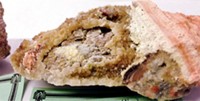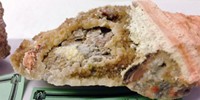Advertisement
Grab your lab coat. Let's get started
Welcome!
Welcome!
Create an account below to get 6 C&EN articles per month, receive newsletters and more - all free.
It seems this is your first time logging in online. Please enter the following information to continue.
As an ACS member you automatically get access to this site. All we need is few more details to create your reading experience.
Not you? Sign in with a different account.
Not you? Sign in with a different account.
ERROR 1
ERROR 1
ERROR 2
ERROR 2
ERROR 2
ERROR 2
ERROR 2
Password and Confirm password must match.
If you have an ACS member number, please enter it here so we can link this account to your membership. (optional)
ERROR 2
ACS values your privacy. By submitting your information, you are gaining access to C&EN and subscribing to our weekly newsletter. We use the information you provide to make your reading experience better, and we will never sell your data to third party members.
Environment
Fizzy extraction brings out semivolatile compounds
Extracting semivolatile compounds with carbon dioxide bubbles reduces the need for heat and solvents
by XiaoZhi Lim
September 2, 2016

When Pawel L. Urban cracked open a soda on the beach in southern Taiwan last summer, he suddenly became aware of the soda’s aroma wafting up to his nose. The analytical chemist from National Chiao Tung University thought that if carbon dioxide bubbles could bring out the soda’s aroma molecules, perhaps that same idea could be applied in the lab to do chemical extraction.
Now, Urban has done just that, reporting a new technique to extract semivolatile compounds from liquids based on the phenomenon of effervescence (Anal. Chem. 2016, DOI: 10.1021/acs.analchem.6b02074). The technique, which Pawel dubs “fizzy extraction,” operates at room temperature and provides sample analysis within seconds of bubble formation.
“It is a fantastic idea,” says Miguel de la Guardia, an analytical chemist at the University of Valencia not involved in the study. “It is a simple and fast procedure.” Traditional methods typically require heat to liberate the semivolatile compounds, consuming energy and exposing samples to potential chemical reactions that can interfere with sample analysis.
Urban designed and built a small fizzy extraction system, and his graduate student Cheng-Hao Chang tested it on a range of samples with different volatilities, including ethyl acetate, caffeine, limonene, and extracts from lime juice and peel. They first placed a water-ethanol solution of each sample in a glass vial and flushed the space above the liquid with CO2 for about a minute. Then, they maintained 150 kPa of CO2 pressure in the space for another minute while vigorously stirring the sample solution, saturating the solution with the gas. Opening a valve allowed the system to depressurize quickly, producing lots of bubbles that immediately carry the semivolatile compounds in each sample into a connected mass spectrometer.
For highly volatile compounds such as ethyl acetate, or nonvolatile compounds like caffeine, fizzy extraction doesn’t increase their gas phase concentration for analysis, Urban says. But for semivolatile compounds such as limonene found in lime juice and peel, fizzy extraction increases their gas phase concentration by up to 20-fold. Urban believes fizzy extraction could be useful for chemical analysis in the food and beverage sectors, as well as in environmental remediation.
De la Guardia would like to see fizzy extraction being tested on a larger variety of samples and its energy and solvent consumption evaluated. Meanwhile, Urban is working to understand the mechanism. He speculates that fizzy extraction works because the semivolatile compounds have some affinity for the carrier gas, in this case CO2, and stick to the bubbles in the instant that they form. To that end, Urban plans to test fizzy extraction using different carrier gases.





Join the conversation
Contact the reporter
Submit a Letter to the Editor for publication
Engage with us on Twitter